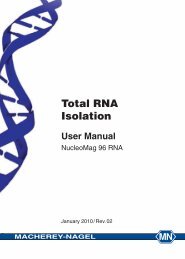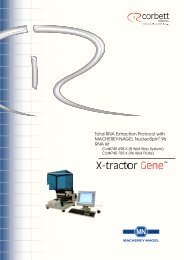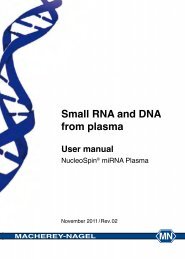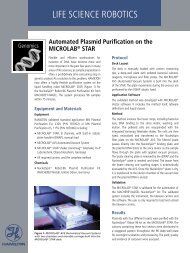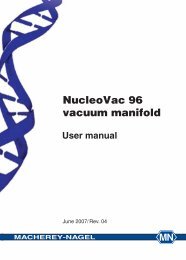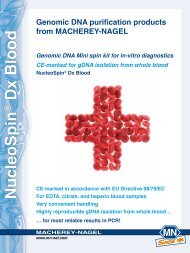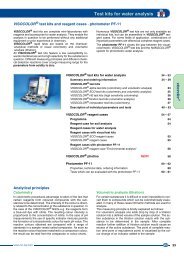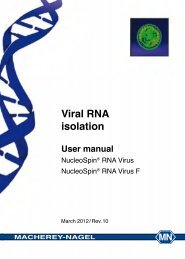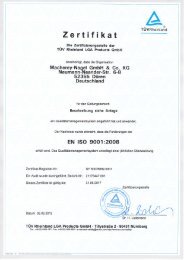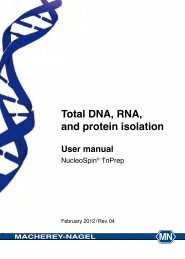bondEX EtBr - Macherey Nagel
bondEX EtBr - Macherey Nagel
bondEX EtBr - Macherey Nagel
Create successful ePaper yourself
Turn your PDF publications into a flip-book with our unique Google optimized e-Paper software.
Detoxification<br />
of <strong>EtBr</strong><br />
User manual<br />
bONdEX <strong>EtBr</strong><br />
May 2004/Rev. 02<br />
MACHEREY-NAGEL<br />
MN
Detoxifi cation of <strong>EtBr</strong><br />
Table of contents<br />
1 Kit contents 4<br />
2 Product description 5<br />
2.1 The basic principle 5<br />
2.2 Specifications of the <strong>bondEX</strong> <strong>EtBr</strong> system 6<br />
2.3 Important remarks and hints 6<br />
3 Easy methods for checking <strong>EtBr</strong> concentrations and capacity 8<br />
3.1 Saran wrap method 8<br />
3.2 TLC plate method 8<br />
3.3 Spectrophotometric measurement 9<br />
3.4 Visualisation of <strong>EtBr</strong> with the <strong>bondEX</strong> indicator cartridge 9<br />
4 Safety instructions – risk and safety phrases 10<br />
5 Protocol for detoxification of buffer solutions 11<br />
6 Appendix 14<br />
6.1 Troubleshooting 14<br />
6.2 Ordering information 15<br />
6.3 Product use restriction / warranty 16<br />
MACHEREY-NAGEL – 05/2004/ Rev 02 3
Detoxification of <strong>EtBr</strong><br />
1 Kit contents<br />
Starter kit<br />
<strong>bondEX</strong> <strong>EtBr</strong><br />
<strong>bondEX</strong> 50 set<br />
Cat. No. 740701 740703<br />
<strong>bondEX</strong> 50<br />
cartridges (with two<br />
end caps)<br />
2 5<br />
Indicator cartridges 6 15<br />
<strong>bondEX</strong> folded filters<br />
XL<br />
10 10<br />
Tank adaptor 1 -<br />
1 l funnel with<br />
adaptor<br />
Small funnel for<br />
<strong>bondEX</strong> folded filters<br />
1 -<br />
1 -<br />
Supporting ring 2 5<br />
Hazard label 2 5<br />
Protocol 1 1<br />
4 MACHEREY-NAGEL – 05/2004/ Rev 02
2 Product description<br />
Detoxifi cation of <strong>EtBr</strong><br />
The most convenient way to visualize DNA in agarose gels is by staining with the<br />
fluorescent dye ethidium bromide (<strong>EtBr</strong>). Such substances intercalate between the<br />
bases of nucleic acids resulting in a higher fluorescence in comparison to the dye in<br />
free solution. Therefore, even small amounts of DNA can be detected. The<br />
disadvantage of <strong>EtBr</strong>-staining is the dye itself - <strong>EtBr</strong> and similar intercalating agents<br />
are powerful mutagens and toxic compounds, too. The decontamination and<br />
removal of waste is often a time consuming and expensive procedure.<br />
2.1 The basic principle<br />
In order to save time and money MACHEREY-NAGEL has developed the <strong>bondEX</strong><br />
<strong>EtBr</strong> cartridges for an easy decontamination of intercalating dye-containing<br />
solutions. After equilibration of the cartridge with methanol or ethanol, the <strong>EtBr</strong><br />
containing solution is simply poured onto the cartridge, which runs by gravity flow.<br />
To improve handling, the <strong>EtBr</strong> containing solution can be provided by a 1 l funnel or<br />
a 1-10 l tank to the <strong>bondEX</strong> <strong>EtBr</strong> cartridge via a connector. The mutagenic dye binds<br />
to the <strong>bondEX</strong> <strong>EtBr</strong> cartridge resulting in a flow-through free of <strong>EtBr</strong>. The binding<br />
efficiency is checked by a capacity indicator cartridge connected to the outlet of the<br />
<strong>bondEX</strong> <strong>EtBr</strong> cartridge.<br />
The <strong>bondEX</strong> system includes:<br />
• 1: prefiltration element<br />
• 2: <strong>EtBr</strong> binding zone<br />
• 3: white, dye-binding zone<br />
1<br />
• 4: removable indicator cartridge<br />
2<br />
3<br />
4<br />
MACHEREY-NAGEL – 05/2004/ Rev 02 5
Detoxification of <strong>EtBr</strong><br />
2.2 Specifications of the <strong>bondEX</strong> <strong>EtBr</strong> system<br />
• Up to 50 mg of <strong>EtBr</strong> can be adsorbed by the <strong>bondEX</strong> <strong>EtBr</strong> 50 cartridges.<br />
• The <strong>bondEX</strong> <strong>EtBr</strong> cartridge is recommended for the extraction of <strong>EtBr</strong> or<br />
SYBR Green from diluted TAE or TBE gel buffers.<br />
• A maximum volume of 50 l filtered solutions containing up to 50 mg <strong>EtBr</strong><br />
can be decontaminated before flow rates decrease and cartridges are<br />
exhausted.<br />
• Prefilter element for improved long term flow rate<br />
• Removable capacity indicator cartridges for monitoring the <strong>bondEX</strong> <strong>EtBr</strong><br />
capacity<br />
• Variable connectors for a 1 l funnel or a 5-10 l tank<br />
2.3 Important remarks and hints<br />
1 <strong>EtBr</strong> solutions > 1 mg/l or high salt buffers should be diluted 1 : 4 with water<br />
before applying them onto the <strong>bondEX</strong> <strong>EtBr</strong> cartridge.<br />
2 Solutions must not contain any organic solvents.<br />
3 In general, 10 µl or less of a 10 mg/ml <strong>EtBr</strong> solution is used for a 100 ml<br />
agarose gel. In consequence, 1 l of gel buffer or staining solution usually<br />
contains about 0.1-0.5 mg/l <strong>EtBr</strong> depending on the number of gels used with<br />
this buffer. We recommend to<br />
• calculate or at least estimate the <strong>EtBr</strong> content of the solutions<br />
• collect the volume corresponding to the permitted maximal amount of<br />
<strong>EtBr</strong> e. g. 10-50 l and decontaminate it continuously.<br />
4 Solutions containing particles or precipitates are not suitable without<br />
pretreatment. In order to prevent clogging of the cartridge, especially for<br />
buffers containing agarose particles, a filtration step using our <strong>bondEX</strong><br />
folded filters XL (supplied) has to be performed before decontamination .<br />
The <strong>bondEX</strong> system was developed for standard TBE and TAE gel buffers. Old or<br />
viscous e. g. staining solutions with precipitates / bacterial growth and unknown<br />
contents are not suitable. Filtration is essential for all solutions – “old” buffers,<br />
which are decontaminated by <strong>bondEX</strong> <strong>EtBr</strong> cartridges, may cause reduced flow<br />
rates in comparison with fresh solutions and a limited volume-capacity.<br />
6 MACHEREY-NAGEL – 05/2004/ Rev 02
Detoxifi cation of <strong>EtBr</strong><br />
5 Faster flow-through rates as mentioned may lead to <strong>EtBr</strong> breakthrough! Do<br />
not use additional force! When using new cartridges apply only half<br />
volumes (500 ml on a 1 l funnel) or regulate flow rates by clamps (tank)<br />
until the optimal flow-through rate has been adjusted (about 10-20 ml/min).<br />
6 Depending on the individual buffers (age, viscosity), flow rates decrease<br />
during use. Gel buffers should be decontaminated optimally soon after use.<br />
7 Following our protocol more than 99% of <strong>EtBr</strong> is removed.<br />
8 Be careful when working with <strong>EtBr</strong> solutions and decontaminated filtrate<br />
until absence of <strong>EtBr</strong> was verified. Follow <strong>EtBr</strong> safety data sheet instructions<br />
given by the supplier and the usual guidelines for toxic samples.<br />
9 According to our best knowledge no uniform regulations exist regarding<br />
maximum concentration of <strong>EtBr</strong> allowed for disposal. Contact your local<br />
authorities for further information and regulations.<br />
10 Ames and other tests (Microtox, Mutatox) indicating mutagenic or toxic<br />
effects of <strong>EtBr</strong> detect <strong>EtBr</strong> at concentrations about 50 µg/l. <strong>bondEX</strong><br />
decontaminated filtrates show no toxic or mutagenic effects in the latter<br />
tests. No detailed studies are known about minimal concentration of <strong>EtBr</strong><br />
sufficient for short or long term toxic or mutagenic effects.<br />
The following safety precautions should be taken when using <strong>bondEX</strong> <strong>EtBr</strong>:<br />
• Note the applied amount of <strong>EtBr</strong> solution to calculate end of capacity.<br />
• Control the decontaminated solution by UV transillumination (saran wrap<br />
method) DC or UV spectroscopy 260 - 400 nm (also see section 3).<br />
• Check the capacity status of the system with indicator cartridges.<br />
• Follow guidelines for working with toxic and mutagenic substances given by<br />
local authorities and the ethidium bromide manufacturer.<br />
MACHEREY-NAGEL – 05/2004/ Rev 02 7
Detoxification of <strong>EtBr</strong><br />
3 Easy methods for checking <strong>EtBr</strong> concentrations<br />
and capacity<br />
In order to determine the concentration of <strong>EtBr</strong> in TAE/TBE-buffer solutions or<br />
decontaminated filtrates we recommend four methods:<br />
3.1 Saran wrap method<br />
Mix 10-20 µl of a DNA containing solution (e. g. 0.5-2 µg/µl plasmid or calf thymus<br />
DNA in 1xTE or TAE buffer) with the equal volume of a series of <strong>EtBr</strong> concentration<br />
standards. Spot the mixtures in an ordered array on a sheet of Saran wrap<br />
(parafilm) stretched over an UV transilluminator. Under UV illumination an <strong>EtBr</strong><br />
concentration of about 0.05-5 µg/ml is detectable by its fluorescence. The same test<br />
is done with the decontaminated solution. The <strong>EtBr</strong> fluorescence can be<br />
photographed for a better estimation of <strong>EtBr</strong> concentrations in comparison to the<br />
standard series. An exact determination is possible if the described assay is<br />
measured in a fluorescence spectrophotometer using 520/540 nm for excitation and<br />
586 nm for detection.<br />
A<br />
B<br />
The picture shows a saran wrap with spots of<br />
decreasing concentrations of <strong>EtBr</strong> on a UV<br />
transilluminator. On the upper lane 5, 1, 0.5,<br />
0.25, 0.1, 0.05 and 0 µg <strong>EtBr</strong>/ml TAE<br />
solutions were mixed with equal volumes of<br />
pBS in TE (15 µl each). Below a 2 µg/ml <strong>EtBr</strong><br />
containing sample (A, left spot) was<br />
decontaminated – the BondEx flow-through<br />
contains no detectable <strong>EtBr</strong> (B, right spot).<br />
3.2 TLC plate method<br />
Pipette 5 µl solution onto a TLC plate (e. g. usual silica thin layer plates). <strong>EtBr</strong><br />
containing solutions can be detected under an UV hand lamp by its fluorescence.<br />
8 MACHEREY-NAGEL – 05/2004/ Rev 02
Detoxifi cation of <strong>EtBr</strong><br />
3.3 Spectrophotometric measurement<br />
Measure a UV-spectrum between 260 and<br />
400 nm and compare the solutions which<br />
contain <strong>EtBr</strong> and which are BondEx<br />
decontaminated. The absorption at about<br />
285 nm indicating <strong>EtBr</strong> is absent in<br />
decontaminated solutions. Don´t forget to<br />
zero the background using the same buffer<br />
as blank. About 0.05-0.1 µg/ml can still be<br />
detected. The measurement may be<br />
interfered by nucleic acids, nucleotides,<br />
salts or dyes, which may be present in<br />
agarose gel buffers. In the latter case<br />
method 3.1 should be used. The figure<br />
shows an UV spectrum from a 1x TAE gel<br />
buffer with 0.5 µg/ml <strong>EtBr</strong> (1) and the<br />
solution after bondEx EtBR treatment (2).<br />
3.4 Visualisation of <strong>EtBr</strong> with the <strong>bondEX</strong> indicator<br />
cartridge<br />
If the capacity of bondEx <strong>EtBr</strong> cartridge is<br />
exhausted <strong>EtBr</strong> breakthrough is<br />
monitored by the connected indicator<br />
cartridge. Daylight exposure shows then<br />
a red-brown ring (right picture) while<br />
under UV exposure (left picture) an<br />
intensive fluorescence is visible.<br />
Resulting from traces of <strong>EtBr</strong> weak<br />
background fluorescence may occur<br />
even before the bondEx <strong>EtBr</strong> cartridge is<br />
exhausted. This background is without<br />
importance. Check the indicator cartridge<br />
frequently and substitute it by a new one<br />
every 10-15 l flow-through and<br />
additionally if other dyes (bromophenol<br />
blue), strong background fluorescence,<br />
or contamination render the indicator<br />
cartridge useless.<br />
MACHEREY-NAGEL – 05/2004/ Rev 02 9
Detoxification of <strong>EtBr</strong><br />
4 Safety instructions – risk and safety phrases<br />
The components of the <strong>bondEX</strong> <strong>EtBr</strong> kits do not contain hazardous contents.<br />
Nevertheless, please watch the safety instructions given in section 2.3 regarding<br />
handling of <strong>bondEX</strong> <strong>EtBr</strong> kits.<br />
10 MACHEREY-NAGEL – 05/2004/ Rev 02
ondEX <strong>EtBr</strong><br />
5 Protocol for detoxification of buffer solutions<br />
Attention : Keep cartridge vertical and remove yellow cap. Reddish brown<br />
binding matrix is covered by a foamed filter element, which may become loose<br />
during transportation. If this is the case, tap the cartridge several times onto the<br />
desk in order to compress the binding matrix and push the foamed filter disc<br />
back on the binding matrix.<br />
1 Initially equilibration of the cartridges<br />
• For the first use it is necessary to equilibrate <strong>bondEX</strong> and indicator<br />
cartridges once.<br />
• Remove the indicator cartridge and equilibrate it separately as described<br />
below.<br />
• Fill the <strong>bondEX</strong> <strong>EtBr</strong> cartridge once with methanol or ethanol (96-100%).<br />
Flow-through starts by gravity and should be finished within 10 min.<br />
Afterwards, fill the <strong>bondEX</strong> <strong>EtBr</strong> cartridge with water and let it run through<br />
completely.<br />
• Initially, it is also necessary to equilibrate every new indicator cartridge<br />
before use once with about 1 ml of ethanol (96-100%) and then 5 ml of<br />
water. Press the solutions into the indicator cartridges using a syringe (or<br />
wash bottle) but avoid drying of cartridges.<br />
• At last, attach the indicator cartridge to the outlet of the <strong>bondEX</strong> <strong>EtBr</strong><br />
cartridge and close it with the appropiate cap.<br />
2 Decontamination of <strong>EtBr</strong> solutions<br />
• The <strong>bondEX</strong> system should consist of an equilibrated <strong>bondEX</strong> 50<br />
cartridge with an attached, equilibrated indicator cartridge which is<br />
closed by the appropiate cap. Either a 5-10 l tank or the 1 l funnel<br />
(supplied in the starter kit) is connected to the <strong>bondEX</strong> <strong>EtBr</strong> cartridge by<br />
the appropiate adaptor (also supplied in the starter kit).<br />
• First, moisten the <strong>bondEX</strong> <strong>EtBr</strong> cartridge with about 10 ml of water or<br />
gel buffer (this is not necessary if the cartridgde was already stored under<br />
water after last use. Usage of “dried” cartridges may cause decreased<br />
flowrates).<br />
• Apply filtered <strong>EtBr</strong> solutions by opening the tank tap or by filling the 1 l<br />
funnel. Remove cap from the indicator cartridge: the flow-through starts<br />
and should not exceed 20 ml/min<br />
MACHEREY-NAGEL – 05/2004/ Rev 02 11
ondEX <strong>EtBr</strong><br />
(In general, if single drops can be detected flow rates are OK). Inhibiting<br />
air bubbles or minor clogging indicated by a low flow-through can be<br />
removed by tapping 2-3 x against the cartridge.<br />
• When the solution has passed the cartridge, close the outlet of the<br />
indicator cartridge.<br />
3 Usage and check of capacity of indicator cartridges<br />
• The end of the <strong>EtBr</strong> binding capacity of the <strong>bondEX</strong> <strong>EtBr</strong> 50 cartridge is<br />
indicated by a colour change of the white zone in the indicator cartridges.<br />
Don´t forget to equilibrate those indicator cartridges initially and attach it<br />
to the outlet of <strong>bondEX</strong> <strong>EtBr</strong> cartridges.<br />
• The white zone in indicator cartridges turns from white to red when<br />
the <strong>bondEX</strong> <strong>EtBr</strong> cartridge is exhausted: First, a red ring can be<br />
detected and the <strong>bondEX</strong> <strong>EtBr</strong> cartridge has now to be replaced. Under<br />
UV this ring can be verified by its strong, orange fluorescence.<br />
• Other dyes or coloured contaminations like bromophenol blue may also<br />
stain indicator cartridges, thus, making it more difficult to recognize <strong>EtBr</strong><br />
breakthrough. In consequence, (blue) coloured or blocked indicator<br />
cartridges should be replaced immediately!<br />
In summary, a colour change of the indicator cartridge can have several<br />
reasons – please read the Troubeshooting in section 6.1 for additional<br />
information.<br />
Red ring/ fluorescent ring:<br />
• <strong>bondEX</strong> <strong>EtBr</strong> cartridge is exhausted and has to be substituted.<br />
• The flow rate is too high and has to be regulated < 20 ml/min.<br />
• The concentration of <strong>EtBr</strong> is too high (> 1 mg/l) and has to be diluted<br />
before decontamination.<br />
Weak background fluorescence:<br />
• This effect is caused by tiny amounts of <strong>EtBr</strong> passing the <strong>bondEX</strong> <strong>EtBr</strong><br />
cartridge. Change the indicator cartridge frequently every 10-15 l.<br />
12 MACHEREY-NAGEL – 05/2004/ Rev 02
ondEX <strong>EtBr</strong><br />
Strong visible colour change e. g. blue / no fluorescence:<br />
• Other dyes used in electrophoresis (e. g. bromophenol blue) will cause a<br />
coloured indicator cartridge. Change the indicator cartridge frequently e.<br />
g. every 10-15 l.<br />
4 Storage of cartridges in use<br />
• After use, the <strong>bondEX</strong> <strong>EtBr</strong> cartridge should be closed with the supplied<br />
end cap when attached to the adaptor (storage 1-7 days), or with the 2<br />
different caps enclosed in the kit for long term storage (1-12 weeks).<br />
• In order to prevent drying and microbial growth in the column, cover it<br />
with about 5 ml water (containing about 0.1 % sodium-azide for long term<br />
storage).<br />
• ATTENTION: Do not store the cartridge for longer periods than 12<br />
weeks, do not expose it to direct sunlight or to temperatures above 30 °C<br />
in order to prevent drying of the gel matrix. Exhausted cartridges should<br />
be marked by hazard labels (supplied) and collected separately in a<br />
special waste container.<br />
Though, <strong>bondEX</strong> <strong>EtBr</strong> cartridges can be stored (see hints above),<br />
continuous decontamination from a daily refilled tank system is the best<br />
method of using <strong>bondEX</strong> <strong>EtBr</strong> cartridges!<br />
MACHEREY-NAGEL – 05/2004/ Rev 02 13
Detoxification of <strong>EtBr</strong><br />
6 Appendix<br />
6.1 Troubleshooting<br />
Problem<br />
Possible cause and suggestions<br />
<strong>bondEX</strong> <strong>EtBr</strong> cartridges show low or even no flow rates<br />
• Knock 2-3 x against the <strong>bondEX</strong> <strong>EtBr</strong> cartridge in order to<br />
remove air bubbles and blocking.<br />
• Change indicator cartridge.<br />
• Check waste for precipitates or bacterial growth (filter it<br />
immediately before loading onto the <strong>bondEX</strong> system).<br />
No or bad<br />
flow rate<br />
• Use <strong>bondEX</strong> <strong>EtBr</strong> cartridges preferentially when a larger<br />
volume of waste was collected e. g. 10 l in order to maintain<br />
permanent use.<br />
• Always add some ml water to used cartridges before attaching<br />
them to the funnel, load filtered waste and finally remove outlet<br />
stopper below the cartridge.<br />
• Cartridges stored for a longer period should be loaded first with<br />
about 10 ml water in order to wet the white prefiltration element<br />
covering the red binding matrix. Soak the prefiltration element<br />
with water if the system has dried out.<br />
Fluorescence<br />
in the<br />
indicator<br />
cartridge<br />
Weak background fluorescence<br />
• Though, typically more than 99% of <strong>EtBr</strong> is removed by <strong>bondEX</strong><br />
<strong>EtBr</strong> decontamination, residual traces of <strong>EtBr</strong> in the flowthrough<br />
may lead to weak background fluorescence in the<br />
indicator cartridge. This is no problem – only strong<br />
fluorescence or a red ring as shown in section 3.4 are<br />
indicating that the <strong>bondEX</strong> <strong>EtBr</strong> cartridge has to be changed.<br />
Nevertheless, we recommend changing the indicator cartridge<br />
itself frequently and control decontaminated flow-through for<br />
presence of <strong>EtBr</strong> in order to be on the safe side.<br />
14 MACHEREY-NAGEL – 05/2004/ Rev 02
Detoxification of <strong>EtBr</strong><br />
Fluorescence<br />
in the<br />
indicator<br />
cartridge<br />
(continued)<br />
Weak fluorescent ring<br />
• Under certain conditions tiny amounts of <strong>EtBr</strong> may pass the<br />
<strong>bondEX</strong> <strong>EtBr</strong> cartridge although it is not exhausted. In<br />
consequence, <strong>EtBr</strong> is bound in the indicator cartridge itself<br />
indicated by a fluorescenct ring visible under UV radiation. If<br />
this is the case, flow rates or <strong>EtBr</strong>-concentrations in the solution<br />
may be too high. A flow rate of < 20 ml/min is OK. The <strong>EtBr</strong><br />
concentration should be optimal below 0.5 mg/ml. Alternatively,<br />
pH or salt concentration of the solutions may be far away from<br />
usual TAE/TBE buffer. Organic components (ethanol, methanol<br />
etc.) also diminish binding efficiency of <strong>bondEX</strong> <strong>EtBr</strong> cartridges.<br />
Check everything, use a new indicator cartridge and restart the<br />
decontamination process. If the fluorescent ring appears again<br />
after 1-2 l flowthough the system is exhausted and should be<br />
replaced.<br />
(Blue) coloured indicator cartridges<br />
• Other dyes used in electrophoresis (e. g. bromophenol blue)<br />
will cause a coloured indicator cartridge. Change the indicator<br />
cartridge. The white, dye-binding zone in the <strong>bondEX</strong> <strong>EtBr</strong><br />
cartridge itself (see picture in section 2.1) will bind most of the<br />
dyes.<br />
If problems arise, generally check the decontaminated waste for presence of<br />
<strong>EtBr</strong> and handle all solutions and parts of the system with care according to<br />
the toxic and mutagenic potential of <strong>EtBr</strong>.<br />
6.2 Ordering information<br />
Product Cat. No. Pack of<br />
<strong>bondEX</strong> starter kit 740701 1 set<br />
<strong>bondEX</strong> 50 set 740703 5 sets<br />
<strong>bondEX</strong> folded filters XL 740705 50<br />
MACHEREY-NAGEL – 05/2004/ Rev 02 15
Detoxification of <strong>EtBr</strong><br />
6.3 Product use restriction / warranty<br />
<strong>bondEX</strong> kit components were developed, designed and sold for research<br />
purposes only. No claim or representation is intended for the decontamination of<br />
any specific solution containing fluorescent staining agents. It is rather the<br />
responsibility of the user to verify the use of the <strong>bondEX</strong> kit for a specific application<br />
range.<br />
This MACHEREY-NAGEL product is shipped with documentation stating<br />
specifications and other technical information. MACHEREY-NAGEL warrants to<br />
meet the stated specifications. MACHEREY-NAGEL´s sole obligation and the<br />
customer´s sole remedy is limited to replacement of products free of charge in the<br />
event products fail to perform as warranted. Supplementary reference is made to<br />
the general business terms and conditions of MACHEREY-NAGEL, which are<br />
printed on the price list. Please contact us if you wish an extra copy.<br />
MACHEREY-NAGEL does not warrant against damages or defects arising in<br />
shipping and handling (transport insurance for customers excluded), or out of<br />
accident or improper or abnormal use of this product; against defects in products or<br />
components not manufactured by MACHEREY-NAGEL, or against damages<br />
resulting from such non-MACHEREY-NAGEL components or products.<br />
MACHEREY-NAGEL makes no other warranty of any kind whatsoever, and<br />
SPECIFICALLY DISCLAIMS AND EXCLUDES ALL OTHER WARRANTIES OF ANY<br />
KIND OR NATURE WHATSOEVER, DIRECTLY OR INDIRECTLY, EXPRESS OR<br />
IMPLIED, INCLUDING, WITHOUT LIMITATION, AS TO THE SUITABILITY,<br />
REPRODUCTIVITY, DURABILITY, FITNESS FOR A PARTICULAR PURPOSE OR<br />
USE, MERCHANTABILITY, CONDITION, OR ANY OTHER MATTER WITH<br />
RESPECT TO MACHEREY-NAGEL PRODUCTS.<br />
In no event shall MACHEREY-NAGEL be liable for claims for any other damages,<br />
whether direct, indirect, incidental, compensatory, foreseeable, consequential, or<br />
special (including but not limited to loss of use, revenue or profit), whether based<br />
upon warranty, contract, tort (including negligence) or strict liability arising in<br />
connection with the sale or the failure of MACHEREY-NAGEL products to perform in<br />
accordance with the stated specifications. This warranty is exclusive and<br />
MACHEREY-NAGEL makes no other warranty expressed or implied.<br />
The warranty provided herein and the data, specifications and descriptions of this<br />
MACHEREY-NAGEL product appearing in MACHEREY-NAGEL published<br />
catalogues and product literature are MACHEREY-NAGEL´s sole representations<br />
concerning the product and warranty. No other statements or representations,<br />
written or oral, by MACHEREY-NAGEL´s employees, agent or representatives,<br />
except written statements signed by a duly authorized officer of MACHEREY-<br />
NAGEL are authorized; they should not be relied upon by the customer and are not<br />
a part of the contract of sale or of this warranty.<br />
Product claims are subject to change. Therefore please contact our Technical<br />
Service Team for the most up-to-date information on MACHEREY-NAGEL products.<br />
You may also contact your local distributor for general scientific information.<br />
Applications mentioned in MACHEREY-NAGEL literature are provided for<br />
16 MACHEREY-NAGEL – 05/2004/ Rev 02
Detoxification of <strong>EtBr</strong><br />
informational purposes only. MACHEREY-NAGEL does not warrant that all<br />
applications have been tested in MACHEREY-NAGEL laboratories using<br />
MACHEREY-NAGEL products. MACHEREY-NAGEL does not warrant the<br />
correctness of any of those applications.<br />
Please contact:<br />
MACHEREY-NAGEL Germany<br />
Tel.: +49 (0) 24 21 969-270<br />
e-mail: TECH-BIO@mn-net.com<br />
MACHEREY-NAGEL – 05/2004/ Rev 02 17



